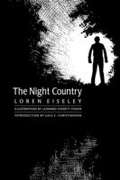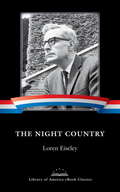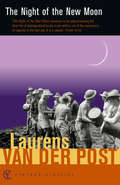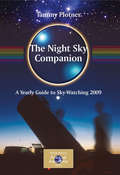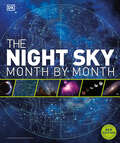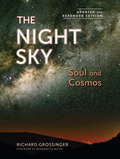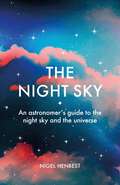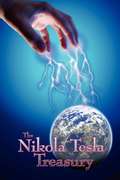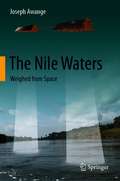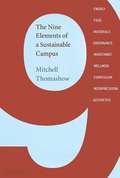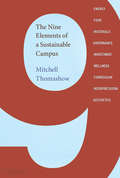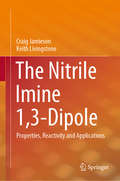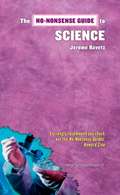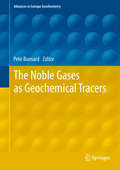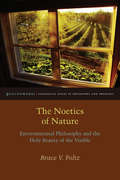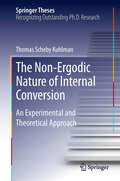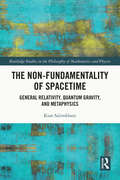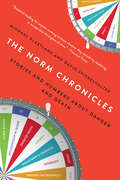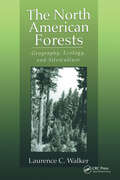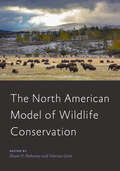- Table View
- List View
The Night Country
by Loren EiseleyToward the end of his life, Loren Eiseley reflected on the mystery of life, throwing light on those dark places traversed by himself and centuries of humankind. The Night Country is a gift of wisdom and beauty from the famed anthropologist.
The Night Country: A Library of America eBook Classic
by Loren Eiseley William CrononWeaving together memoir, philosophical reflection, and his always keen observations of the natural world, Loren Eiseley's essays in The Night Country explore those moments, often dark and unexpected, when chance encounters disturb our ordinary understandings of the universe. The naturalist here seeks neither "salvation in facts" nor solace in wild places: discovering an old bone or a nest of wasps, or remembering the haunted spaces of his lonely Nebraska childhood, Eiseley recognizes what he calls "the ghostliness of myself," his own mortality, and the paradoxes of the evolution of consciousness.
The Night Of The New Moon
by Sir Laurens Van Der PostThis book is the remarkable story of his experiences in the prison camp, but it is also a meditation on the morality of the Bomb, a compassionate and moving contemplation of human violence.
The Night Sky Companion
by Ken Vogt Tammy PlotnerThe Night Sky Companion 2009 takes a look at astronomy every day over the course of the year - offering an overview of general history, soft science, astronomical trivia, and observing guides and motivation. Designed to appeal to readers at all skill levels and involvement, it provides a digest for sky watchers interested in all-in-one-place information that includes history, current events, and of course interesting objects to be observed on any given day. The Moon is followed through its phases with observing instructions, annotated pictorial maps, concise photos, and the science and history of what makes lunar observing a fascinating challenge. It is important to realise that the 2009 edition does not repeat anything of the previous edition. All the historical tie-ins, information and objects are completely fresh. A reader who buys the 2009 edition will not have merely an updated copy of the previous volume - they will have a completely new book. Unaided-eye observers are offered an opportunity to view many objects or events; learn about their history, science and how just "looking up" can be rewarding. Binocular and small telescope users will find a wealth of things to view using simple star hop instructions and finder charts. This book is more than just an observing guide, it's a way of learning your way round the night sky. Large-aperture telescope users looking for a challenge are not ignored either. Some of the finest deep-sky objects are detailed, with finder maps and photographs, most of them taken by talented amateurs. Be it a meteor shower, double stars, variable stars, solar viewing, lunar features, a variety of catalog studies, history or the physics and science behind the stars - you'll find it here, written in an easy-going style ideal for 'dipping in' on the relevant day, or even reading from cover to cover.
The Night Sky Month by Month
by DKYou&’ll be seeing stars all year round in this dazzling guide to the night sky.This comprehensive reference book shines bright with crystal-clear month-by-month charts of the planets, stars, and constellations in the northern and southern hemispheres. The Night Sky Month by Month features specially-commissioned artworks and stunning photography introducing the main attractions to spot every month, including bright stars, key constellations, and meteor showers.You can get started with ideas for the best equipment to use and top tips for budding beginners and amateur astronomers alike. Then see for yourself how views of the night sky change dramatically depending on the location and time. Soon you&’ll be navigating the night sky for yourself, following the paths of the planets, tracking the phases of the Moon, and preparing for special celestial events. Get ready to find your place in the Universe with the ultimate night sky atlas.
The Night Sky, Updated and Expanded Edition
by Richard Grossinger Bernadette MayerEver since Homo sapiens first looked up at the stars, we as a species have been looking for meaning in the mysteries of the night sky. Over the millennia, as our knowledge, science, and technology developed, the stories we told ourselves about the universe and our place in it developed as well. In The Night Sky, Richard Grossinger traces those developments, covering multiple aspects of humanity's complex relationship to the cosmos. Covering not only astronomy but also cosmology, cosmogony, astrology, and science fiction, he offers us a revelatory look at the firmament through his own telescope, fitted with an anthropological lens.Throughout his explorations, Grossinger continually reflects on the deeper meaning of our changing concepts about the universe and creation, offering insight into how each new discovery causes us to redefine the values, moralities, and aesthetics by which we live. He also calls into question the self-aggrandizing notion that humanity can and will conquer all, and injects our strident confidence in science with a healthy dose of humility and wonder. Filled with poetic observation and profound questions, The Night Sky is a brilliant reflection of humanity's relationship with the cosmos--a relationship fed by longing, doubt, and awe.
The Night Sky: An astronomers guide to the night sky and the universe (Usborne Spotter's Guides)
by Nigel HenbestDiscover the wonders of the Universe with this indispensable guide. The Night Sky is chock full of information explaining what, when and how to observe space and understanding the night sky.Not only accessible, but also invaluable, this is the perfect practical guide for both budding and seasoned astronomers, an easy introduction to astronomy and a useful resource for more experienced stargazers.
The Night Sky: An astronomers guide to the night sky and the universe (Usborne Spotter's Guides)
by Nigel HenbestDiscover the wonders of the Universe with this indispensable guide. The Night Sky is chock full of information explaining what, when and how to observe space and understanding the night sky.Not only accessible, but also invaluable, this is the perfect practical guide for both budding and seasoned astronomers, an easy introduction to astronomy and a useful resource for more experienced stargazers.
The Nikola Tesla Treasury
by Nikola TeslaHere's the Tesla collection you've been waiting for: 214 figures; 668 pages; and 107 articles, letters to editors, and lectures. All the famous lectures and articles that you'd expect are here, You'll also get his many letters to editors, commenting on Marconi, Edison, and many issues of the day. And if that wasn't enough you'll also get other articles that you've heard about but probably never seen. This is an amazing collection that will give you the most complete look into the mind of Nikola Tesla, who has been called the most important man of the 20th Century. Without Tesla's ground-breaking work we'd all be sitting in the dark without even a radio to listen to.
The Nile Waters: Weighed from Space
by Joseph AwangeThis book is useful to those in water resources management and policy formulations, hydrologists, environmentalists, engineers and researchers. Exploiting advanced statistical techniques and the latest state-of-the-art multi-mission satellites, surface models and reanalysis products, this book provides the first comprehensive weighing of the changes in the Nile River Basin’s (NRB: ~ 3,400,000 km2 ) stored waters' compartments, surface, soil moisture and groundwater, and their association to climate variability/change and anthropogenic impacts on the one hand. On the other hand, it argues on the need for equitable use of the NRB’s waters by all 11 countries within its basin, and doing away with obsolete Nile treaties that were signed by Britain, Egypt and Sudan, which prohibit the use of the Nile by 8 upstream countries. With Ethiopia’s construction of Africa’s largest dam (GERD; Grand Ethiopian Renaissance Dam) along the Blue Nile, which is expected to take several years to fill, the Nile is back on the news. Combined with Uganda’s Nalubaale, Kiira and Bujagali dams on the White Nile, these human-induced impacts (i.e., damming), coupled with those of climate variability/change, are expected to exacerbate tension with the low stream countries (Egypt and Sudan) fearing the cut in theNile’s total volume. Furthermore, the Nile river, arguably the world’s longest river (6800 km), impacts on the livelihood of over 300 million people of 11 countries within its basin. This population is expected to double in the next twenty-five years, thereby putting extreme pressure on its water resources. An in-depth analysis of changes in the Nile’s stored waters, therefore, is essential to inform its management and sustainable equitable use. Owing to its sheer size, however, obtaining in-situ data from “boots on the ground” is practically impossible, paving way to the space-based weighing of the Nile River Basin using a suite of high spatio-temporal remotely sensed and reanalysis products, as well as those of hydrological models. “Arguably, the Nile River is the most unique river in the world. It spans extremes of rainfall from being measured by meters to being measured by centimeters, from the humid tropics to the driest of deserts. Yet, thirsty people live throughout this basin and therefore the demands on its water resources are uneven. Knowing the water amounts throughout the entire Nile Basin is a critical step for governments and international treaties to avoid the “Tragedy of the Commons”. Africa can embrace this future through the leadership of Prof. Awange and others like him who have devoted their careers to Africa’s waters” —Doug Alsdorf, Ph.D., Professor of Geophysics at the Ohio State University (USA).
The Nine Elements of a Sustainable Campus
by Anthony Cortese Mitchell ThomashowA college campus offers an ideal setting for exploring and practicing sustainability. Colleges and universities offer our best hope for raising awareness about the climate crisis and the dire threat it poses to the planet. They provide opportunities for both research and implementation; they have the capacity to engage students, staff, and faculty in collaborative enterprises that inspire campus transformation; they take the idea of legacy seriously. But most college and university administrations need guidance on the path to sustainability. In The Nine Elements of a Sustainable Campus, Mitchell Thomashow, a former college president, provides just that. When Thomashow became president of Unity College, a small environment-focused college in Maine, in 2006, he decided to focus his leadership on sustainability. Drawing on his experiences at Unity, Thomashow identifies nine elements for organizing a sustainability agenda: energy, food, and materials (aspects of infrastructure); governance, investment, and wellness (aspects of community); and curriculum, interpretation, and aesthetics (aspects of learning). Thomashow describes, among other things, how Unity built the first platinum LEED-certified college president's residence in North America; installed solar panels, wind turbines, and other renewable energy generators all over the campus; became a center for local food growing; reconsidered the college's capital assets and investment strategy in light of sustainability; revitalized the curriculum; and made the entire campus a canvas for sustainability-inspired public art. Connecting his experiences to broader concerns, Thomashow links the campus to the planet, reminding us that local efforts, taken together, can have a global impact.
The Nine Elements of a Sustainable Campus
by Mitchell ThomashowA former college president offers a framework for sustainability on campus, describing initiatives that range from renewable energy to a revamped curriculum to sustainable investment. Colleges and universities offer our best hope for raising awareness about the climate crisis and the other environmental threats. But most college and university administrations need guidance on the path to sustainability. In The Nine Elements of a Sustainable Campus, Mitchell Thomashow, a former college president, provides just that. Drawing on his experiences at Unity College in Maine, he identifies nine elements for a sustainability agenda: energy, food, and materials (aspects of infrastructure); governance, investment, and wellness (aspects of community); and curriculum, interpretation, and aesthetics (aspects of learning). He then describes how Unity put these elements into practice. Connecting his experiences to broader concerns, Thomashow links the campus to the planet, reminding us that local efforts, taken together, can have a global impact.
The Nitrile Imine 1,3-Dipole: Properties, Reactivity and Applications (Springerbriefs In Molecular Science Ser.)
by Craig Jamieson Keith LivingstoneThis book provides a comprehensive overview of the nitrilimine 1,3-dipole, from its initial discovery in 1959 to the most recent publications. Covering topics such as the core properties of the dipole and the various methods of synthesis available, it particularly highlights the diverse reactivity profile of the nitrilimine and its numerous applications in bioorthogonal and materials chemistry. The book is of interest to academic and industrial researchers working in this area and to those new to the field.
The No-Nonsense Guide to Science
by Jerome RavetzScience is the great intellectual adventure, but can also be an instrument of profit, power, and privilege. Wrongly used, it might yet make the twenty-first century our last. To make sense of this, we need to let go of old ideas and assumptions.<P><P>This No-Nonsense Guide to Science introduces a new way of thinking about science, moving away from ideas of perfect certainty and objectivity. We must accept uncertainty and ignorance in the field, as well as the need for citizens' participation in the policies involving science.
The Noble Gases as Geochemical Tracers
by Pete BurnardThe twelve chapters of this volume aim to provide a complete manual for using noble gases in terrestrial geochemistry, covering applications which range from high temperature processes deep in the Earth's interior to tracing climatic variations using noble gases trapped in ice cores, groundwaters and modern sediments. Other chapters cover noble gases in crustal (aqueous, CO2 and hydrocarbon) fluids and laboratory techniques for determining noble gas solubilities and diffusivities under geologically relevant conditions. Each chapter deals with the fundamentals of the analysis and interpretation of the data, detailing sampling and sampling strategies, techniques for analysis, sources of error and their estimation, including data treatment and data interpretation using recent case studies.
The Noble Gases as Geochemical Tracers (Advances in Isotope Geochemistry)
by Pete BurnardThe twelve chapters of this volume aim to provide a complete manual for using noble gases in terrestrial geochemistry, covering applications which range from high temperature processes deep in the Earth’s interior to tracing climatic variations using noble gases trapped in ice cores, groundwaters and modern sediments. Other chapters cover noble gases in crustal (aqueous, CO2 and hydrocarbon) fluids and laboratory techniques for determining noble gas solubilities and diffusivities under geologically relevant conditions. Each chapter deals with the fundamentals of the analysis and interpretation of the data, detailing sampling and sampling strategies, techniques for analysis, sources of error and their estimation, including data treatment and data interpretation using recent case studies.
The Nocturnal Brain: Nightmares, Neuroscience, and the Secret World of Sleep
by Dr. Guy LeschzinerA renowned neurologist shares the true stories of people unable to get a good night’s rest in The Nocturnal Brain: Nightmares, Neuroscience, and the Secret World of Sleep, a fascinating exploration of the symptoms and syndromes behind sleep disorders.For Dr. Guy Leschziner’s patients, there is no rest for the weary in mind and body. Insomnia, narcolepsy, night terrors, apnea, and sleepwalking are just a sampling of conditions afflicting sufferers who cannot sleep—and their experiences in trying are the stuff of nightmares. Demoniac hallucinations frighten people into paralysis. Restless legs rock both the sleepless and their sleeping partners with unpredictable and uncontrollable kicking. Out-of-sync circadian rhythms confuse the natural body clock’s days and nights.Then there are the extreme cases. A woman in a state of deep sleep who gets dressed, unlocks her car, and drives for several miles before returning to bed. The man who has spent decades cleaning out kitchens while “sleep-eating.” The teenager prone to the serious, yet unfortunately nicknamed Sleeping Beauty Syndrome stuck in a cycle of excessive unconsciousness, binge eating, and uncharacteristic displays of aggression and hypersexuality while awake.With compassionate stories of his patients and their conditions, Dr. Leschziner illustrates the neuroscience behind our sleeping minds, revealing the many biological and psychological factors necessary in getting the rest that will not only maintain our physical and mental health, but improve our cognitive abilities and overall happiness.
The Noetics of Nature: Environmental Philosophy and the Holy Beauty of the Visible (Groundworks: Ecological Issues in Philosophy and Theology)
by Bruce V. FoltzContemplative or “noetic” knowledge has traditionally been seen as the highest mode of understanding, a view that persists both in many non-Western cultures and in Eastern Christianity, where “theoria physike,” or the illumined understanding of creation that follows the purification of the heart, is seen to provide deeper insights into nature than the discursive rationality modernity has used to dominate and conquer it.Working from texts in Eastern Orthodox philosophy and theology not widely known in the West, as well as a variety of sources including mystics such as the Sufi Ibn ‘Arabi, poets such as Basho, Traherne, Blake, Hölderlin, and Hopkins, and nature writers such as Muir, Thoreau, and Dillard, The Noetics of Nature challenges both the primacy of the natural sciences in environmental thought and the conventional view, first advanced by Lynn White, Jr., that Christian theology is somehow responsible for the environmental crisis.Instead, Foltz concludes that the ancient Christian view of creation as iconic—its “holy beauty” manifesting the divine energies and constituting a primal mode of divine revelation—offers the best prospect for the radical reversal that is needed in our relation to the natural environment.
The Non-Ergodic Nature of Internal Conversion
by Thomas Scheby KuhlmanThis thesis investigates the transitions from one electronically excited state to another. Such processes - the fastest of events in chemistry - can be studied with femtosecond resolution, and Thomas S. Kuhlman approaches the question both with experimental and theoretical methods. His approach contributes to explain processes of high importance to all scientific fields concerned with the interaction between light and matter: the deactivation of the electronically excited states after excitation. Thomas S. Kuhlman concludes in this thesis that the electronic transition proceeds before the entire set of available degrees of freedom are active - 'It is as simple as that' !
The Non-Fundamentality of Spacetime: General Relativity, Quantum Gravity, and Metaphysics (Routledge Studies in the Philosophy of Mathematics and Physics)
by Kian SalimkhaniThis book argues that our current best theories of fundamental physics are best interpreted as positing spacetime as non-fundamental. It is written in accessible language and largely avoids mathematical technicalities by instead focusing on the key metaphysical and foundational lessons for the fundamentality of spacetime. According to orthodoxy, spacetime and spatiotemporal properties are regarded as fundamental structures of our world. Spacetime fundamentalism, however, faces challenges from speculative theories of quantum gravity – roughly speaking, the project of applying the lessons of quantum mechanics to gravitation and spacetime. This book demonstrates that the non-fundamentality of spacetime does not rely on speculative physics alone. Rather, one can give an interpretation of general relativity that supports some form of spacetime non-fundamentalism. The author makes the case for spacetime non-fundamentalism in three steps. First, he confronts the standard geometrical interpretation of general relativity with Brown and Pooley’s dynamical approach to relativity theory. Second, he considers an alternative derivation of the Einstein field equations, namely the classical spin-2 approach, and argues that it paves the way for a refined dynamical approach to general relativity. Finally, he argues that particle physics can serve as a continuity condition for the metaphysics of spacetime. The Non-Fundamentality of Spacetime will be of interest to scholars and advanced students working in philosophy of physics, philosophy of science, and metaphysics.
The Nora Notebooks, Book 2: The Trouble with Babies
by Claudia Mills Katie Kath"The thought-provoking reflections on personality and growth add insight and discussability."--The Bulletin of the Center for Children's Books Fourth grade scientists are not meant to be babysitters. The second book in the Nora Notebooks finds Nora Alpers in unfamiliar territory. Nora Alpers has just become a ten-year-old aunt. To prepare for the new arrival, Nora has been writing down baby-related facts in her special notebook, just like she does with her favorite subject: ants. She likes the idea that someone who studies the A-N-T is also an A-U-N-T, even though she doesn't know anything about taking care of babies. A new family member isn't the only thing stressing Nora out. At school, Nora has to write journals in the voice of a pioneer on the Oregon Trail and prepare for the annual science fair. Science is normally Nora's best subject--until Nora ends up being paired with science-hating, cat-obsessed Emma! How will Nora ever learn to be a good aunt if she's trying to survive the Oregon Trail and arguing against Emma's unscientific science-fair ideas? Readers will welcome the return of Nora who Publishers Weekly called "delightful[ly] enterprising" in a starred review.From the Hardcover edition.
The Nora Notebooks, Book 3: The Trouble with Friends
by Claudia Mills Katie KathThe final book in the Nora Notebooks series finds Nora trying to navigate the unscientific matter of making friends with someone you have nothing in common with. Nora Alpers, fourth-grade scientist, likes things to be just so. Her ant farm, her hobbies, her friends. So when Coach Joe, her teacher, informs the class that all the students have to try something new and write a report about it, Nora is not pleased. She is even less pleased when her classmate Emma seems to decide that befriending Nora will be her “new” thing. Does Emma really want to be friends or is this just an assignment for school? Nora, meanwhile, has to figure out her own new thing. Will she discover that she has interests outside of science or will all her efforts end up being nothing but trouble? Praise for the Nora Notebooks series: “Will resonate with children who have a passion for something out of the ordinary.” —Publishers Weekly, starred “Readers will be drawn into the story by the sincere and realistic characters Mills has created, as well as the pleasing and appealing illustrations found in every chapter.” —School Library Journal “Middle-grade readers will hope for more Nora Notebooks soon.” —Kirkus Reviews
The Norm Chronicles: Stories and Numbers About Danger and Death
by Michael Blastland David SpiegelhalterA statistician and a journalist reveal the real story behind the statistics on risk, chance, and choice
The North American Forests: Geography, Ecology, and Silviculture
by Laurence C. WalkerThe North American Forests: Geography, Ecology, and Silviculture describes where, why, and how the many kinds of trees found on this continent grow in silvical associations - called forest cover types. Thirteen chapters describe more than 100 forest cover types, involving several times that many species. Diverse woodlands discussed include: o The Arctic tundra o Florida's tropics o The Atlantic's coastal pond pines o The Pacific's Monterey pines o The summits of Englemann spruce o Sea-Level swamps of baldcypress The text acts as a singular guidebook for specialists and students in natural resource disciplines examining the geography, ecology, and silvicultural practices for sustaining North American forests; students in curriculum's involving regional silviculture; and persons examining the goods and services from this varied, fascinating renewable resource. Benefiting from the author's five decades of practicing forestry, the reader will trek into virtually every "neck of the woods" - perusing exceptional field notes and photographs of the continent's forests. Featureso Offers a summary of forests in North America, ecological positions, and best management approaches for the benefit of mankind o Contains a readable language for both college students and professionals o Provides information covering the forests of Canada and the US o Lists "Further Readings" and "Subjects for Discussion and Essay" at the end of each chapter o Includes more than 100 photographs Audience o Foresters o Ecologists o Natural Resource Managers o Forestry Students
The North American Model of Wildlife Conservation (Wildlife Management and Conservation)
by Shane P. Mahoney and Valerius GeistThe foremost experts on the North American Model of Wildlife Conservation come together to discuss its role in the rescue, recovery, and future of our wildlife resources.At the end of the nineteenth century, North America suffered a catastrophic loss of wildlife driven by unbridled resource extraction, market hunting, and unrelenting subsistence killing. This crisis led powerful political forces in the United States and Canada to collaborate in the hopes of reversing the process, not merely halting the extinctions but returning wildlife to abundance. While there was great understanding of how to manage wildlife in Europe, where wildlife management was an old, mature profession, Continental methods depended on social values often unacceptable to North Americans. Even Canada, a loyal colony of England, abandoned wildlife management as practiced in the mother country and joined forces with like-minded Americans to develop a revolutionary system of wildlife conservation. In time, and surviving the close scrutiny and hard ongoing debate of open, democratic societies, this series of conservation practices became known as the North American Model of Wildlife Conservation.In this book, editors Shane P. Mahoney and Valerius Geist, both leading authorities on the North American Model, bring together their expert colleagues to provide a comprehensive overview of the origins, achievements, and shortcomings of this highly successful conservation approach. This volume• reviews the emergence of conservation in late nineteenth–early twentieth century North America• provides detailed explorations of the Model's institutions, principles, laws, and policies• places the Model within ecological, cultural, and socioeconomic contexts• describes the many economic, social, and cultural benefits of wildlife restoration and management• addresses the Model's challenges and limitations while pointing to emerging opportunities for increasing inclusivity and optimizing implementationStudying the North American experience offers insight into how institutionalizing policies and laws while incentivizing citizen engagement can result in a resilient framework for conservation. Written for wildlife professionals, researchers, and students, this book explores the factors that helped fashion an enduring conservation system, one that has not only rescued, recovered, and sustainably utilized wildlife for over a century, but that has also advanced a significant economic driver and a greater scientific understanding of wildlife ecology.Contributors: Leonard A. Brennan, Rosie Cooney, James L. Cummins, Kathryn Frens, Valerius Geist, James R. Heffelfinger, David G. Hewitt, Paul R. Krausman, Shane P. Mahoney, John F. Organ, James Peek, William Porter, John Sandlos, James A. Schaefer
